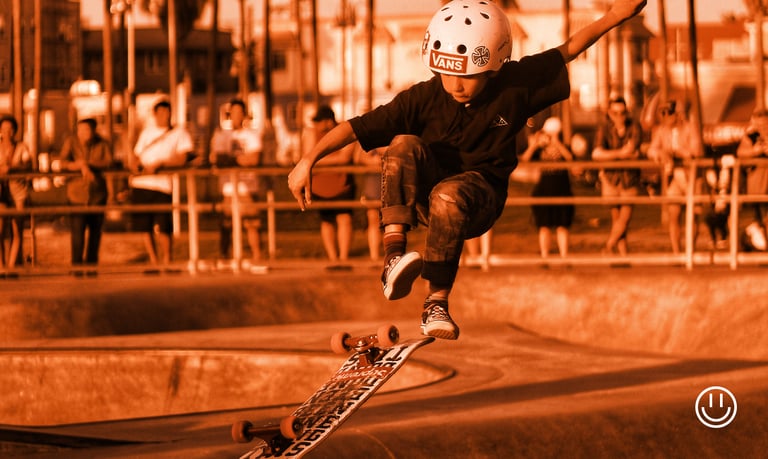Rolling into the World of Skateboarding: Your Ultimate Guide
SPORT


Rolling into the World of Skateboarding: Your Ultimate Guide
Rolling into the World of Skateboarding: Your Ultimate Guide
Introduction
Skateboarding is a thrilling sport that combines physical skill, creativity, and a sense of freedom. Whether you're a beginner looking to get started or an experienced skater aiming to refine your skills, this guide covers everything you need to know about skateboarding, including its types, how to skateboard, safety precautions, alternatives, essential gear, and frequently asked questions.
What is Skateboarding?
Skateboarding involves riding and performing tricks on a skateboard, a board mounted on four wheels. It originated in the 1940s and has since evolved into a popular sport, recreational activity, and even a mode of transportation.
Types of Skateboards
1. Traditional Skateboards: These have a double kicktail (curved ends) and are used for street and park skating, tricks, and stunts.
2. Longboards: Longer and often more stable than traditional skateboards, longboards are used for cruising, downhill racing, and transportation.
3. Cruiser Skateboards: Shorter than longboards but longer than traditional skateboards, cruisers are designed for easy riding and commuting.
4. Electric Skateboards: Powered by a battery and motor, electric skateboards provide effortless cruising and can reach high speeds.
How to Skateboard: Basic Techniques
Getting Started
1. Choosing a Skateboard: Select a skateboard that fits your style, whether it's a traditional skateboard for tricks or a longboard for cruising.
2. Safety Gear: Always wear a helmet, knee pads, elbow pads, and wrist guards to protect yourself from falls and injuries.
Basic Skills
1. Stance:
- Regular Stance: Left foot forward.
- Goofy Stance: Right foot forward.
- Try both stances to see which feels more comfortable.
2. Pushing Off:
- Place your front foot on the board.
- Use your back foot to push off the ground and gain momentum.
- Place your back foot on the board once you're moving.
3. Turning:
- Lean in the direction you want to turn.
- For sharper turns, lift the front wheels slightly by applying pressure to the tail.
4. Stopping:
- Use the tail to drag on the ground (tail stop).
- Step off the board and slow down gradually.
Basic Tricks
1. Ollie:
- Pop the tail of the board with your back foot.
- Slide your front foot forward to level the board in mid-air.
2. Kickflip:
- Perform an ollie.
- Flick the board with your front foot to make it spin.
3. Manual:
- Lift the front wheels and balance on the back wheels.
- Maintain balance by shifting your weight.
Precautions for Skateboarding
1. Warm-Up: Always perform a proper warm-up to prevent muscle strains and injuries.
2. Safe Environment: Skate in designated areas like skate parks, away from traffic and pedestrians.
3. Check Your Gear: Regularly inspect your skateboard for any damage or loose parts.
4. Learn to Fall: Practice falling safely to minimize injury, using your protective gear effectively.
5. Stay Aware: Be mindful of your surroundings and other skaters.
Alternatives to Skateboarding
If skateboarding isn't suitable for you, consider these alternatives:
1. Roller Skating: Similar balance and movement but with four wheels on each foot.
2. Inline Skating: Uses rollerblades with wheels in a single line.
3. Scootering: Riding a scooter can offer a similar thrill and skill set.
4. Surfing: Uses similar balance and techniques, but on water.
Essential Gear
1. Skateboard: Choose a skateboard that matches your style and skill level.
2. Helmet: Protects your head from serious injuries.
3. Pads: Knee pads, elbow pads, and wrist guards to protect against falls.
4. Skate Shoes: Durable shoes with good grip and cushioning.
5. Tool Kit: A skateboard tool for making adjustments and repairs.
FAQs
Q1: How do I choose the right skateboard for me?
A1: Consider your intended use (tricks, cruising, transportation) and choose a board that matches. Beginners may find wider decks and softer wheels easier to handle.
Q2: How long does it take to learn to skateboard?
A2: It varies, but with regular practice, most people can learn the basics within a few weeks.
Q3: Is skateboarding safe for kids?
A3: Yes, with appropriate safety gear and supervision, skateboarding can be safe and enjoyable for children.
Q4: Can I skateboard in the rain?
A4: It's not recommended, as wet surfaces can be slippery, and water can damage the skateboard.
Q5: How do I maintain my skateboard?
A5: Regularly check and tighten bolts, clean bearings, and replace worn-out parts like wheels and grip tape.
Conclusion
Skateboarding is a dynamic and exciting sport that offers a unique combination of physical exercise and creative expression. Whether you're riding through city streets, practicing tricks at the skate park, or cruising down a scenic path, the key is to stay safe, practice regularly, and have fun. Grab your board, gear up, and start your skateboarding journey today!
---
For more tips, tricks, and skateboarding-related content, subscribe to our blog and follow us on social media.
- Facebook:
- Twitter:
- Instagram:
Contact Us
Have questions or suggestions? Contact us at info@bukars.com
---
This comprehensive guide covers all aspects of skateboarding, making it a valuable resource for beginners and experienced skaters alike.
